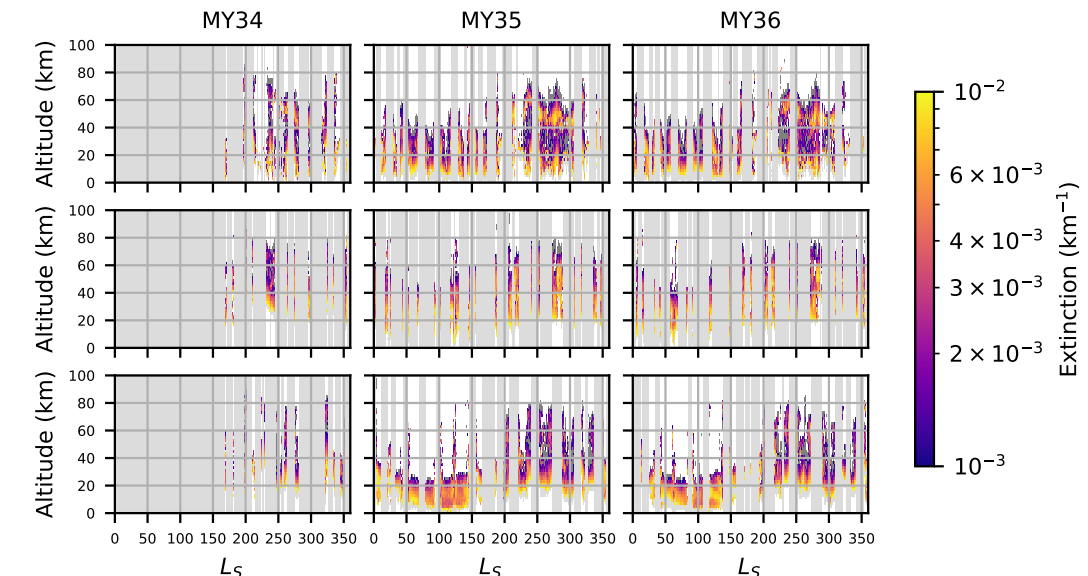- 1Royal Belgian Institute for Space Aeronomy, BIRA-IASB
- 2Université libre de Bruxelles (ULB), Spectroscopy, Quantum Chemistry and Atmospheric Remote Sensing (SQUARES), Brussels, Belgium
- 3Space Science Institute, 4750 Walnut Street, Suite 205, Boulder, CO 80301, UCB 564, USA
- 4Instituto de Astrofisica e Planetologia Spaziali, INAF, Rome, Italy
- 5School of Physical Sciences, The Open University, Milton Keynes, UK
- 6Instituto de Astrofìsica de Andalucía, Consejo Superior de Investigaciones Científicas (CSIC), Granada, Spain
Aerosols are an important part of the Martian atmosphere. They are composed of dust, H2O ice, and CO2 ice. Dust is the main aerosol and has a significant contribution to the radiative transfer budget, as it absorbs solar radiation, leading to local heating of the atmosphere. Dust is confined to lower altitudes during the aphelion season and can reach higher altitudes during the perihelion, especially during dust storms that frequently arise on Mars during this period. The seasonal behavior of the dust will lead to temperature variations in the atmosphere that are important, especially for modelers. Ice clouds are more present during the aphelion when the temperature is colder and follow a seasonal pattern. Different types of clouds can be found throughout the year and contrary to dust, they reflect sunlight and locally cool the atmosphere.
The thermal and dynamical structure of the atmosphere, as well as the distribution of chemical species are sensitive to the aerosol’s abundance and size.
The NOMAD (“Nadir and Occultation for MArs Discovery”) spectrometer suite onboard the ExoMars Trace Gas Orbiter (TGO) is composed of three spectrometers. In this work, we will use the UVIS and SO channels in occultation mode. Both channels are respectively in the UV-Visible (200-650 nm) and infrared (2.3-4.3 µm).
We first developed a methodology to compute extinction and particle sizes with the UVIS channel. The climatology produced allowed us to study aerosols along different seasons and latitudes between the second half of Martian Year (MY) 34 up to the end of MY 36 (figure 1).
Using only the spectral range of UVIS in occultation, dust, H2O ice, and CO2 ice cannot be differentiated because the three aerosols have similar extinction features. To model the extinction cross-section, we assume spherical symmetry and use a Mie scattering code (Bohren, et al., 1998). We use the commonly used log-normal size distribution with the parameterization of (Hansen, et al., 1974).
We show that with UVIS it is possible to distinguish size between 0.1 to 0.8 µm with confidence. When the particles are larger, it is not possible to retrieve the precise size, as the spectra does not possess any absorption bands.
With the addition of the infrared channel, NOMAD SO, we can broaden the sensitivity with respect to particle size and can retrieve the composition of the aerosols. H2O ice, CO2 ice, and dust possess different signatures in the IR (figure 2) and it is possible to differentiate them with confidence. The combination of both UVIS and SO greatly improves the retrieval of particle size as it allows us to have more sensitivity for larger particles.
Several works have already published climatologies of aerosols with NOMAD. Liuzzi et al., (2019) study water ice cloud and dust particles with the SO channel during MY34 and the beginning of Martian year 35.They were able to discriminate the aerosols and study the presence and evolution of water ice clouds during dust storms. Stolzenbach et al., (2023) also made a similar study , also using SO, from MY 34 to MY 35. Both works were able to study in detail the size distribution during dust events.
Streeter et al (2022), used the UVIS channel to produce a climatology of aerosols between MY34 to the end of MY35. They derived extinction vertical profiles but not the size of the particles. Using a model, they were also able to study the presence of water ice clouds and dust in the atmosphere.
By the combination of previous work’s results, and the methodology developed for the UVIS channel, we aim to create a new climatology covering from MY34 to the end of MY 36. This new data set will use information contained in the UV and IR channels allowing us to have greater constraints on size and composition of the aerosols. We will be able to study in detail the evolution and occurrence of detached layers during several seasons and latitudes.

Figure 1: Extinction vertical profiles with the UVIS channel as a function of LS for the northern ([30°,70°] Lat, Top panel), equatorial ([-30°,30°] Lat, Middle panel), and southern latitude ([-70°,-30°] Lat, Bottom panel) regions for Martian Years 34, 35, and 36. The extinction is taken as the average between 320 and 360 nm. Shaded regions denote periods where there are no observations due to orbital geometry, while the white regions are where the spectrum is rejected. Both sunset and sunrise occultations are averaged in this figure.
Figure 2: Example of SO extinction spectra (in red) showing the absorption due to water ice (in orange) with other aerosols here for comparison.
How to cite: flimon, Z., Erwin, J., Robert, S., Neary, L., Piccialli, A., Trompet, L., Willame, Y., Daerden, F., Bauduin, S., Wolff, M., Thomas, I., Ristic, B., Bellucci, G., Patel, M., Depiesse, C., Vandaele, A.-C., Mason, J. P., Lopez-Moreno, J. J., and Vanhellemont, F.: Aerosol Climatology on Mars as Observed by NOMAD UVIS/SO on ExoMars TGO, Europlanet Science Congress 2024, Berlin, Germany, 8–13 Sep 2024, EPSC2024-1014, https://doi.org/10.5194/epsc2024-1014, 2024.